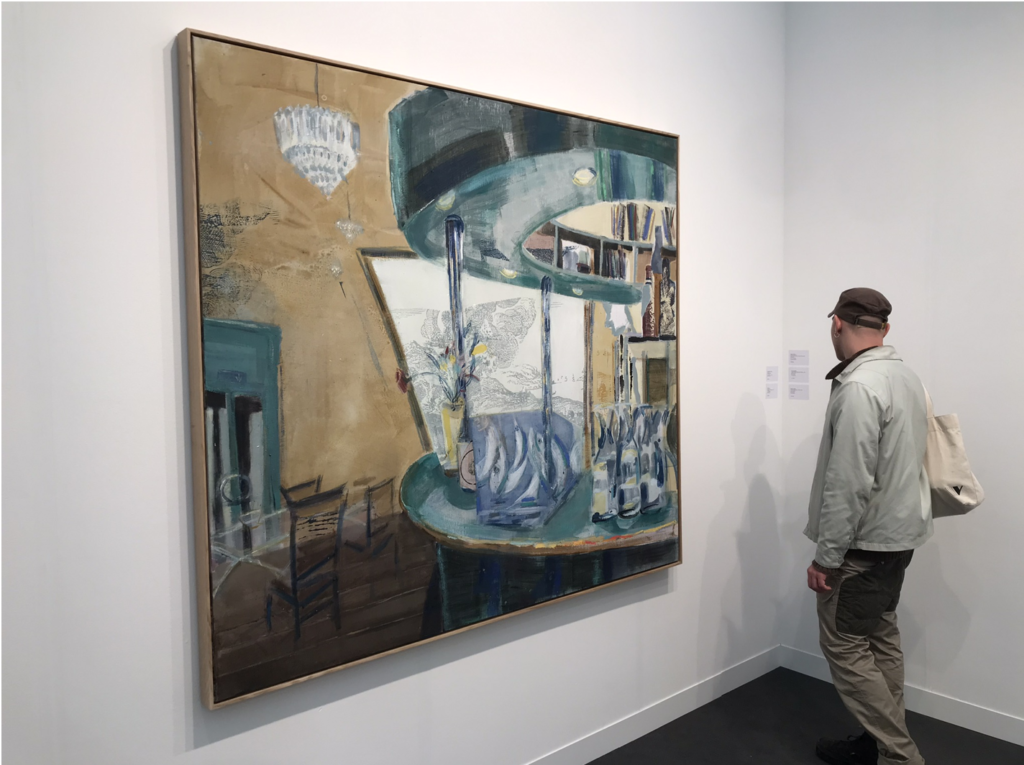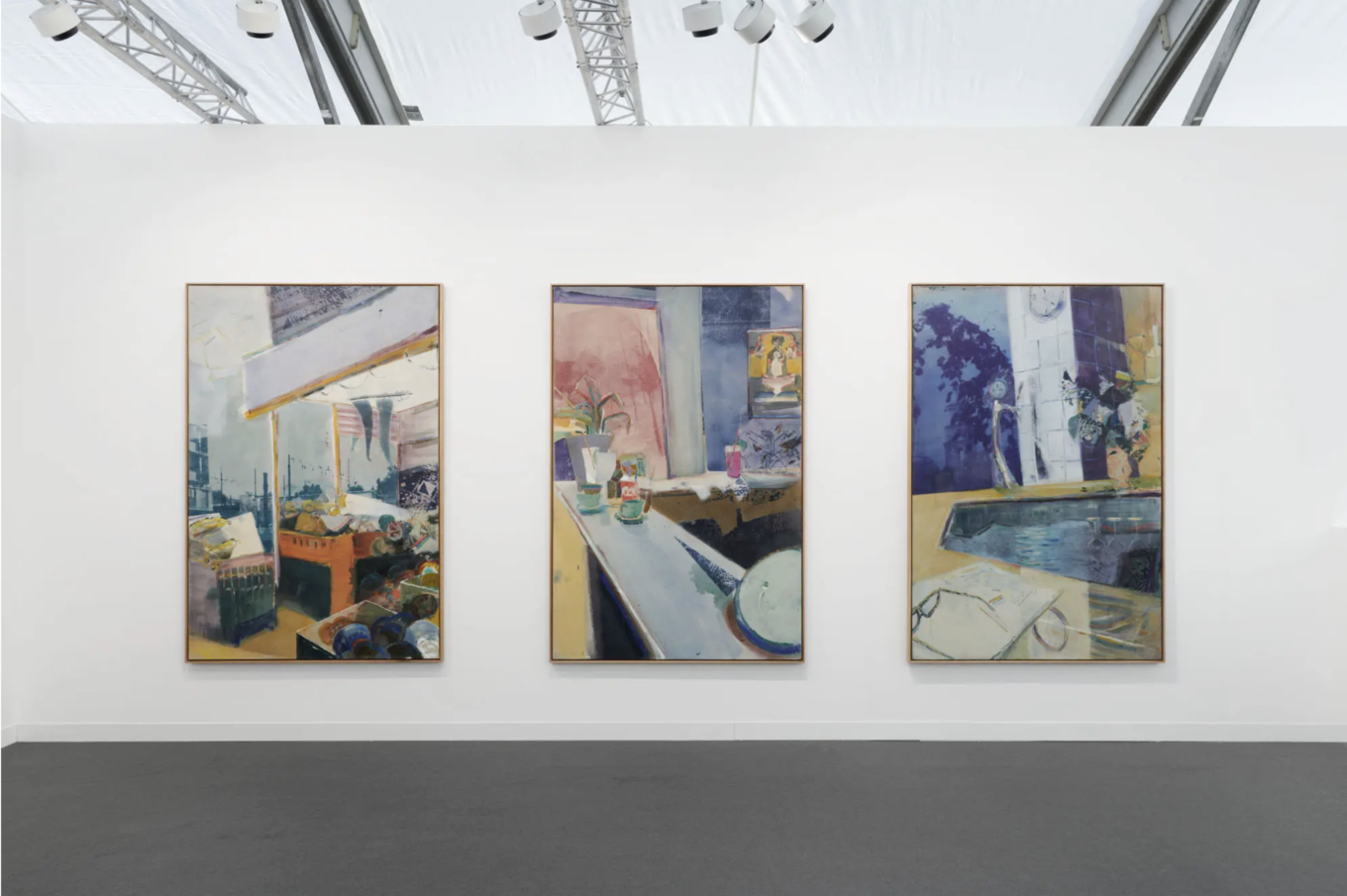The first in a series of interviews by BEN FRITH, with former Slade students showing at Frieze 2023.
Nick Goss Grad. 2006, BA Fine Art, Slade School of Fine Art
This series of interviews is with a group of former Slade School of Fine Art students, whose works were on display at this year’s Frieze London. Coming to the Slade from a wide range of backgrounds, and across a wide range of years, these artists have each approached art and art-making from different perspectives, embedding their personal experiences of place, memory, and identity into their work. Joined together through their shared experience of art school in London, the interviews attest to the diversity of experience that is possible when building a career in London and the wider art world, and will hopefully be a source of solace and encouragement to those looking to a future as an artist.
NICK GOSS is a British artist born in Bristol who graduated from the Slade in 2006. His landscapes are grounded in the imagery of dreams and memory– where time, space and identity sit uneasily on the canvas.
BEN: When did you first realise that art and artmaking was something you were drawn to?
NICK: I remember my Mum was very supportive. She taught my brother and I when we were really young, and she had loads of interesting art books that she would make us read and look at and learn to copy from. In hindsight they were quite an odd, idiosyncratic selection. It was lots of German Expressionist artists, sort of like Franz Marc and Beckmann and also some Matisse and others. We spent long summers in Holland, where my mum was from, and again, we’d have sessions of making drawings and things. But it was always that kind of art, quite fast expressionistic work, nothing pre-1900. It’s funny, I’m still filling that in; lots of my friends and people I admire are into Titian and Velasquez, but I feel like I’m just now learning about them properly.
BEN: Did you have any people early on that really inspired you to think of art as something that you could actually do?
NICK: I had one really eye-opening moment which I’ll always remember. When I was a teenager and was studying for my A Levels in Bristol I got completely obsessed with Basquiat. He was the gateway. It’s just something so visceral about his work for a teenager. And my Mum or my Aunt I can’t quite remember, found out that there were two Basquiat paintings in the Boijmans Van Beuningen in Rotterdam. You couldn’t see these things, they just weren’t in Europe at all, I think it was still pre-email, so we wrote a letter to the director of the Boijmans and they wrote back saying that the pieces were not on show but that they were in the storage, and if I wanted to come they could pull them out and let me look at them. And when I went there, that was just it. The scale and the fact that they were just in these slightly tawdry, Dutch storage cabinets, made it feel like oh, anyone can do this, this is just paint on canvas! It broke down that myth that being an artist was an impossibility. I remember going back and mixing up oils and acrylics in my art block, and I made some terrible paintings, but it was like, that was it, it made it all feel like it was something I could do.

BEN: Do you think your experience living between two countries shaped that way you approached art?
Yeah I think that sense of duality, of coming from two different places and two different environments and having the Netherlands as a place I wasn’t totally used to, like I was with Bristol, definitely impacted my relationship to landscape. I remember being absorbed just by the flatness of the Netherlands, how it’s both mundane but also expectational. I think that’s why I centre a lot of my paintings in what can look like the everyday but has that strangeness to it. But also, the duality of being from two different places, that idea of having two nationalities, two outlooks, that was definitely interesting.
NICK: What was the experience like, for you, then of transitioning out of your home environment and going to art school?
Coming up both to London and art college was sort of mind-blowing. Quite intimidating at the start. At the Slade they mix in the students for the first term, so as a first year I was put in a studio with fourth years for some reason and they really knew what they were doing. We were slightly in at the deep end. But you learnt to sort of fight for what you were doing and what you wanted to make. I’ve never forgotten the comments made by my first tutor who said something like “you have to find a way for your work to justify itself existing in the world, you have to prove that you deserve to make art”. He might not have even said it like that, but it’s what I needed to hear.

BEN: As a student back in Slade, how was the experience of developing your relationship to art making? Was it clear from the start what you wanted to do?
No not really, it’s very bumpy, you have to be so thick skinned because straight away you try to make pieces of work that mimic what you want, and they become something totally different from what you intended. The first piece I really remember liking was one I had done from a study of a photograph I’d taken in Venice of a line of wooden buoys that went out into the lagoon. I painted them quite fast, and they ended up looking more like a strange group of figures migrating across the water. But then straight away I tried to make another painting that did something like that, and they kept coming out as very romantic, escapist pieces. You get some really tough crits from your other peers; I remember one of them saying “these are just really twee!” but you just have to cling onto that feeling you get when you do a piece of work that makes you feel like ‘oh there is something going on here’. It’s a lifetime’s work.
NICK: As this is all about a group of former Slade students who are showing at Frieze, I just wondered if you had any thoughts about the way work by up-and-coming artists is found and shown at Frieze London?
I’m really essentially happy to be showing with so many great artists. Obviously an art fair is just a very small part of how you show as an artist. It works for people who have ‘commercially viable’ work but there are so many great artists out there whose work is less commercially viable, so they don’t get that platform. My one concern would be that it shouldn’t be consumed as ‘the art world’. It’s not representative of everything that’s happening in London, there are so many wonderful, talented artists that I know that aren’t showing at fairs because their work doesn’t fit in with that context. But I mean from my point of view there are so many great artists being shown, whether it’s with Ingleby or Josh Lilley, so I’m really proud to be sharing a wall with them. That’s really cool.
BEN: So, for students who are looking to a future as practicing artists, what would your advice be?
I think you’ve got to use being in London; being in this great, creative hub of a place. Put on shows, go and meet artists, whatever stage their career is in they are always going to be up for meeting you, meeting young artists. That’s the best way to then get an idea of that world. A lot of good things come from artists talking to each, then it feels much less overwhelming. And then all the old cliches are true, just keep making stuff, it’s amazing, and seems unreal, but it’s all possible.
Nick Goss was on show at Frieze London this year with Ingleby Gallery, and currently has a show at the Edinburgh gallery, ‘Smickel Inn, Balcony of Europe’, open until December 16th 2023.





